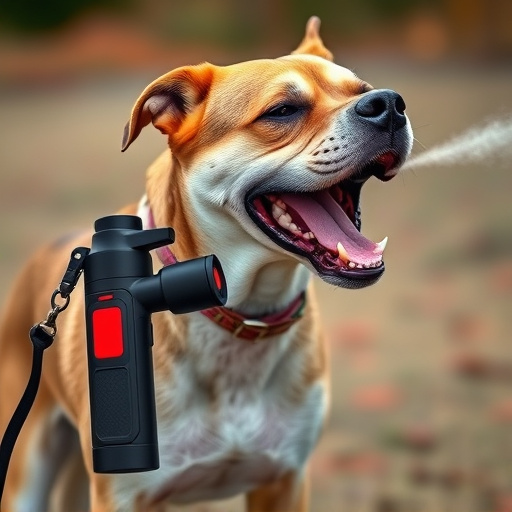Dog aggression can stem from fear, territoriality, or lack of socialization, and pepper spray, used from a safe 3-4 meter distance, disrupts behavior patterns as a last resort. Proper application is key, with a short 2-3 second burst directed slightly above the dog's face. Legal implications vary by region, so understanding local regulations and maintaining a safe spraying distance of at least 20 feet is crucial. Alternatives like positive reinforcement training and desensitization techniques are effective in preventing dog attacks without pepper spray.
“Unleashing Safety: A Comprehensive Guide to Stopping Dog Attacks with Pepper Spray. Discover the power of this non-lethal tool as a last resort against aggressive canine behavior. Our article delves into the science behind dog aggression and the effectiveness of pepper spray, offering a step-by-step guide on safe application—crucial information for maintaining your distance during potentially dangerous encounters (including the optimal safe spraying distance for dogs).
We also explore legal considerations, responsible use practices, and alternative training methods to prevent attacks altogether.”
- Understanding Dog Aggression and Pepper Spray Effectiveness
- Safe Application Technique: Step-by-Step Guide
- Legal Considerations and Responsible Use
- Alternatives and Training Methods for Dog Attack Prevention
Understanding Dog Aggression and Pepper Spray Effectiveness
Dog aggression can stem from various factors, including fear, territorial behavior, or a lack of socialization. When a dog feels threatened, it may react aggressively as a protective mechanism. Understanding these triggers is crucial in mitigating potential attacks. Pepper spray, when used appropriately, can be an effective deterrent for dog aggression due to its irritant properties. It creates a temporary sensory overload that disrupts the dog’s behavior pattern.
The safe spraying distance for dogs is typically around 3-4 meters (10-13 feet). This range allows for accuracy while keeping the user at a safe distance from potential harm. It’s important to note that pepper spray should only be used as a last resort, and training to prevent aggression through positive reinforcement is highly recommended.
Safe Application Technique: Step-by-Step Guide
When using pepper spray as a last resort to stop a dog attack, proper application technique is crucial to ensure safety and effectiveness. It’s important to remember that pepper spray can be dangerous if misused, so understanding the safe spraying distance for dogs is key. Here’s a step-by-step guide to help you apply it correctly:
1. Assess the Situation: Before using pepper spray, quickly scan your surroundings. Make sure you and any others are at a safe distance from the attacking dog, ideally 20-30 feet away, as this is generally considered the safe spraying distance for dogs. Ensure there are no children or pets in close proximity to avoid accidental exposure.
2. Prepare the Spray: Hold the can upright, with the nozzle facing down. Activate the spray mechanism while keeping a firm grip on the can. A good technique involves releasing a short burst of spray, about 2-3 seconds, at an angle slightly above and towards the dog’s face to maximize impact without blowing back into your face.
Legal Considerations and Responsible Use
When considering the use of pepper spray as a deterrent against dog attacks, it’s crucial to understand the legal implications and responsible usage guidelines. Laws surrounding the carrying and use of pepper spray vary by region, so it’s essential to research and comply with local regulations. In many areas, pepper spray is classified as a weapon, which comes with specific restrictions on who can possess and use it. Only individuals over a certain age, such as adults or those with valid concealed carry permits, are typically allowed to carry pepper spray legally.
Safe spraying distance for dogs is another critical aspect that needs careful consideration. To ensure responsible use, it’s recommended to maintain a safe distance of at least 20 feet (around 6 meters) from the dog. This allows for accurate targeting while minimizing the risk of the spray spreading to bystanders or causing excessive harm to the animal. Responsible users should also be trained in proper handling techniques and the effects of pepper spray on dogs, as improper use could lead to severe consequences for both the dog and the handler.
Alternatives and Training Methods for Dog Attack Prevention
When considering dog attack prevention, it’s essential to explore alternatives to pepper spray, as safe spraying distance for dogs can vary greatly and direct application can have adverse effects. Methods like positive reinforcement training and desensitisation techniques are highly effective in teaching dogs to respond calmly to unexpected stimuli, including potential threats from other animals or people.
Incorporating these training methods requires patience and consistency. Rewards-based training encourages good behaviour by associating certain actions with treats or praise. Desensitisation involves gradually exposing the dog to simulated attack scenarios at a safe distance, helping them overcome fear and anxiety responses. This holistic approach not only prevents attacks but also strengthens the bond between owner and pet.
Dog attacks can be frightening, but understanding aggression and employing safe, responsible techniques like pepper spray application can significantly reduce risks. Remember, the ideal safe spraying distance for dogs is around 3-4 feet (1-1.2 meters), giving you time to retreat if needed. Beyond this tool, consider alternative prevention methods and positive reinforcement training to foster a calm environment for both you and your canine counterparts. Always stay informed about local laws regarding pepper spray use and practice responsible, ethical application techniques.
